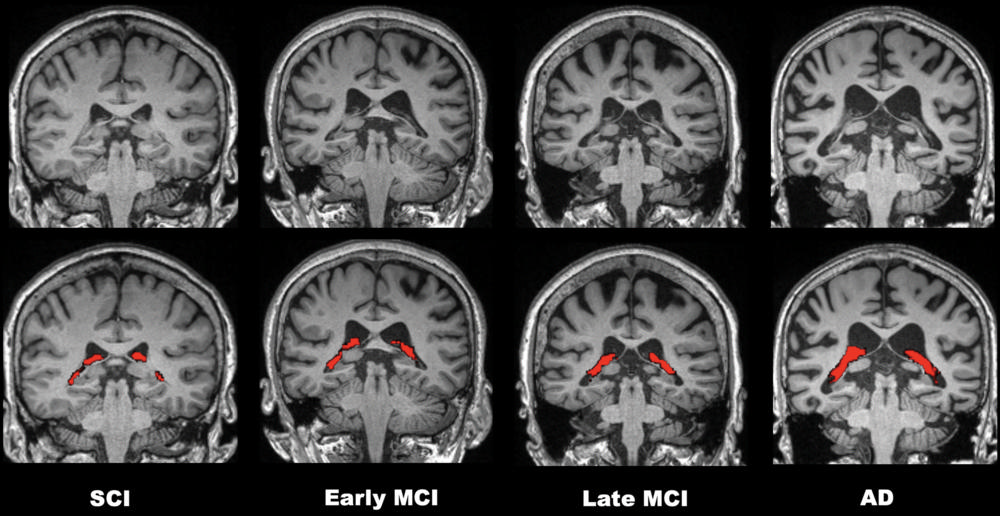Brain Imaging Study Reveals Clues About Dementia’s Behavior Changes
Images

University of Michigan researchers report new clues about what might be happening in the brains of people experiencing even the earliest signs of dementia-related behavior changes. Using two types of advanced medical imaging to study the brains of 128 people in the early stages of dementia, they show links between one of the brain’s most crucial communication networks, a protein called tau, and the level of behavioral symptoms a person has.
This goes beyond the role of tau that scientists have already known about in people with more advanced dementia: causing tangled nerve fibers in brain regions involved in thinking and memory.
The new study suggests that tau disrupts the integrity of the brain’s salience network. This highway of connections between specific brain regions is key to our ability to understand and decide how to react to things that are happening around us. It also helps us process our own thoughts and emotions.
The researchers, from the Research Program on Cognition and Neuromodulation Based Interventions (RP-CNBI), are led by Alexandru D. Iordan, PhD and program leader Benjamin M. Hampstead, PhD. Both are faculty in the U-M Medical School’s Department of Psychiatry. They report their findings in Alzheimer's & Dementia: The Journal of the Alzheimer's Association.
The team used functional MRI (fMRI), to study each volunteer’s brain and trace three different networks that each connect far-flung areas of the brain. They used a measure called the network segregation index, to gauge how functionally independent each network was relative to other brain networks.
They combined fMRI findings with results from a battery of neuropsychological tests and behavioral questionnaires the volunteers took. They also looked at results from positron emission tomography, or PET, scans that showed whether the person’s brain contained excess tau protein as well as beta amyloid, another Alzheimer’s-related protein.
The salience network was the only one of the three networks whose level of integrity correlated with the presence of tau and the severity of dementia-related behavioral issues. The default-mode network appears to be involved as a supporting player. The third network studied, called the frontoparietal network, was not related to behavioral symptoms.
The new study showed that unlike tau, the presence of just amyloid in some volunteers’ brains was not related to issues with the salience network or linked to that person’s level of behavioral symptoms.
Iordan notes that the salience network is also known to be involved in some psychiatric disorders and in frontotemporal dementia, a type of early-onset, rapidly progressing dementia marked mainly by behavioral and personality changes.
The researchers showed that the more a person’s salience network had been disrupted in the presence of tau, the more behavioral changes that person would experience.
While the one-time imaging of these 128 research volunteers can’t show cause and effect, the strong association between tau, salience network disruption and behavior change is intriguing, the team says.
They call for further study of the potential connection in other populations, and for research to evaluate change over time to explore what might be going on within the pathways of connected brain cells that make up the salience network, and explore how it relates to tau buildup and behavioral changes over the course of years.
They also hope to test whether they could slow behavioral change in people with early-stage dementia by targeting the salience network with mild electrical current or magnetic fields applied from outside the skull and guided by precise imaging.
Iordan, a neuroscientist who is lead author of the new study, says, “What we see is that the presence tau pathology relates to behavioral symptoms not in a direct relationship, but rather through dysfunction of a specific network in the brain — the salience network. The more affected this network is, the more severe the behavioral symptoms.”
He adds, “This is the first study that links the biomarker status of an individual with the dysfunction of this network, and behavioral symptoms, in people on the Alzheimer’s disease spectrum.”
Iordan notes that PET scans for tau and amyloid are now used clinically in the diagnosis of dementia, and in managing treatment with new medications that aim to reduce the buildup of amyloid, with the goal of slowing cognitive decline.
But blood tests that can also detect the presence of tau and amyloid, and use them as biomarkers of dementia risk, have also started to become available. Since they’re much less expensive than PET scans, they might also be useful in future studies of tau’s role in behavioral changes too, he says.
Further research could also help explain and even predict variation in the onset of behavioral changes in people with dementia, and the pace of decline. It might also lead to ways to identify people whose behavior changes are their earliest detectable sign of dementia risk, even before cognitive ability changes.
But the most exciting thing to Iordan and his colleagues?
“Our findings provide us with a functional target for potential intervention,” he said. “We will soon be able to see if brain stimulation changes these relationships thanks to a larger study led by Dr. Hampstead that evaluates the effects of different doses of weak electrical currents applied to the brain. This larger study is nearing completion, and we are very excited to see what the results show, so stay tuned!”